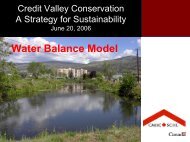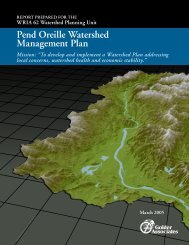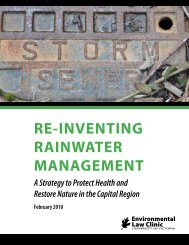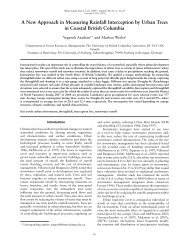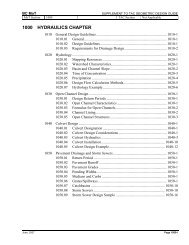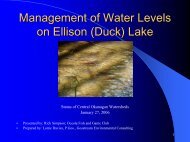Stormwater Source Control Design Guidelines 2005 - Waterbucket
Stormwater Source Control Design Guidelines 2005 - Waterbucket
Stormwater Source Control Design Guidelines 2005 - Waterbucket
Create successful ePaper yourself
Turn your PDF publications into a flip-book with our unique Google optimized e-Paper software.
<strong>Design</strong>, Construction and Maintenance Process <strong>Stormwater</strong> <strong>Source</strong> <strong>Control</strong> <strong>Design</strong> <strong>Guidelines</strong> <strong>2005</strong>SWMMThe SWMM model (RUNOFF and HYDRAULICS Blocks) wasoriginallly developed in 1971 by the US EnvironmentalProtection Agency (EPA). Since that time the model has beenupdated numerous times and now incorporates modelling ofdisconnected surfaces required for <strong>Source</strong> <strong>Control</strong> modelling.Several versions of SWMM are available on the market fromdifferent software suppliers, as well as directly from the EPA asa public domain version.The SWMM software is capable of carrying out hydrologic andhydraulic simulation and features:− industry-standard SWMM analysis engine that is wellproven.− capability for both event (design and/or real storms)and continuous (multi-event, multi-year) modeling.− block modules that allow for expansion to fullydynamic backwater analysis (HYDRAULICS block) andwater quality modeling (TRANSPORT block).Because the SWMM model includes a groundwater routine, itprovides a complete water balance calculation allowingsource control facilities to be sized. The physically-basedmodel parameters provide greater confidence in extendingmodel results beyond those contained in flow monitoring dataset (i.e. to lower or higher return periods).The inputs required for the model include:− rainfall data− evaporation rate data− soil parameters− catchment characteristics such as area, imperviouspercentage, overland flow length, and slopeMost source controls can be modeled using the groundwaterand soil parameters. Because SWMM includes a hydraulicmodel, additional parameters can be entered to size and testconveyance systems and/or detention facilities. Additionalparameters include pipe sizes or open channel cross sections,conduit inverts, roughness values, storage versus elevationrelationships, weir, orifice, and pump data, and variabledownstream water level boundaries (recorded stage or tidal).100Greater Vancouver Sewerage & Drainage District



